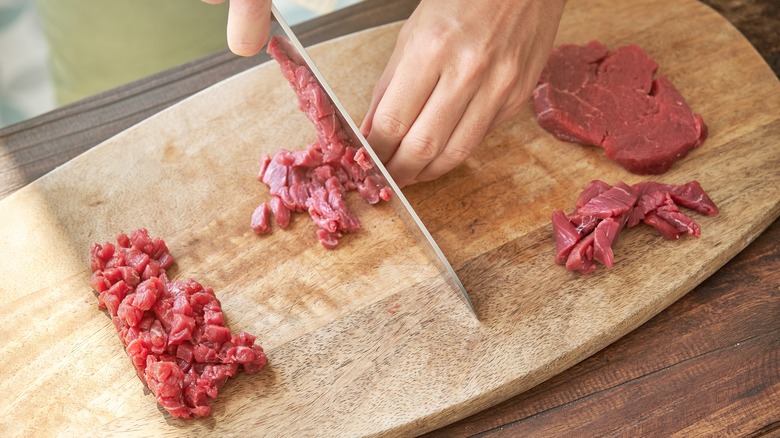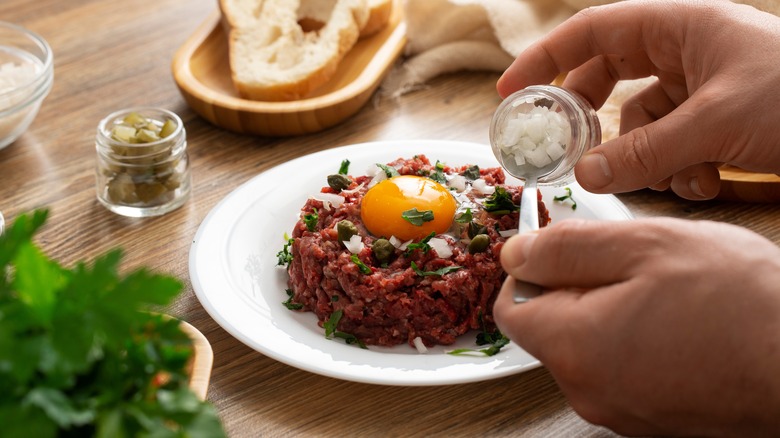Anthony Bourdain's Tip For Making Better Steak Tartare At Home
We may receive a commission on purchases made from links.
Steak tartare is a dish that many people associate with dining out rather than eating at home. In actuality, it's a simple preparation that shouldn't daunt home cooks too much; after all, it doesn't involve any actual cooking. Since it centers around chopped raw beef, good-quality meat is the most important key to success, but chef Anthony Bourdain also emphasized the use of careful technique to get the best results.
Bourdain was a master of fuss-free yet flavorsome and exciting food, so it's not surprising that he wrote about a dish as classic (yet exotic) as steak tartare in his book "Anthony Bourdain's Les Halles Cookbook: Strategies, Recipes, and Techniques of Classic Bistro Cooking." For his recipe, the secret lays not only in the quality of the beef, but in how it's chopped. When making tartare at home, the chef believed the beef should always be finely chopped with a knife by hand. He warned home cooks, "do not dare use a food processor on this dish — you'll utterly destroy it."
The chef was correct that a meat grinder or food processor can turn the tender and toothsome meat into soggy, shapeless mush, especially if you blitz it for too long. Bourdain added that the meat should be chopped right before serving, too. Whatever cut of beef you use, it should be fresh and ideally from a good butcher rather than the grocery store, so you'd do well to follow Bourdain's advice and avoid ruining it.
Tips for chopping steak tartare by hand
Intimidated by the thought of chopping beef finely enough for an elegant tartare? The key to mincing soft, raw steak into even pieces comes down to using an extremely sharp knife, Anthony Bourdain advised. This is because using a dull-edged blade can squish, pull, or tear the delicate protein. The ideal size for the cubes is about ⅛ of an inch, which is small enough to hold together nicely and create a pleasing mouthfeel that enhances the beef's flavor, but not so tiny that the dish turns into a mushy, puree-like mess.
If you're struggling to dice raw beef at room temperature, another great tip is to freeze it briefly first. This is the trick Ina Garten uses for ultra-thin meat slices in dishes such as carpaccio, and it works just as well with tartare. It only takes 15 minutes in the freezer to firm up the beef enough to hold its shape better when chopped.
As for the meat itself, while you'd usually look for good marbling when choosing the perfect steak at the store or butcher shop, tartare has different standards. Fat adds flavor and richness when it renders out during cooking, but when left uncooked, it's tough, greasy, and unpleasant. For tartare, look for a cut that's fairly lean and tender, with no gristle or excess fat; trim these off before chopping, if necessary. Bourdain favored sirloin, but you could also go for something like tenderloin or filet mignon.
How to season and dress steak tartare for the tastiest results
Beef may be the star of steak tartare, but it's the supporting cast of ingredients that really makes it shine. Anthony Bourdain used a cornucopia of flavorsome add-ins to enhance the meat, including mustard, chopped anchovies, Worcestershire sauce, Tabasco, Cognac, onion, salty capers, cornichons, parsley, and ketchup. The ketchup is not as unusual an addition as you might think — even the French gastronomic bible "Larousse Gastronomique" recommends it.
There are tons of ways to put your own spin on this dish. Flecks of chopped red chili add punchy heat, or try brandy rather than Cognac for a boozy boost. A little sherry vinegar can add a sweet-sharp note, or mayonnaise can bring creamy richness to the dish. The one topping you'll see in most recipes is a raw egg yolk nestled in the center of the mound of beef, ready to be broken and mixed into the dish. Bourdain actually liked to mix the yolks with the other ingredients to be combined with the chopped meat, rather than keeping the yolks whole.
You can use pasteurized eggs if you're worried about consuming them raw, or for a truly impressive restaurant-worthy creation (that also cooks the yolks a bit), confit them by slowly cooking them in oil for an hour at 149 degrees Fahrenheit. It gives them a deliciously rich taste and gorgeously oozy consistency.



